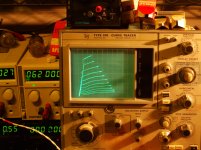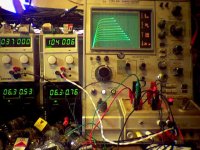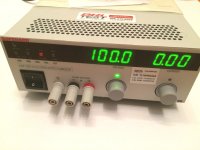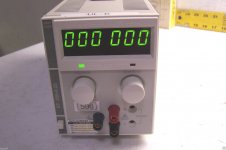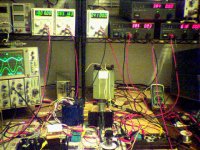Hello All,
What is a Source Measure unit (SMU)?
What Is a Source Measure Unit (SMU)? - National Instruments
Yesterday I unpacked a shiny Keysight B2962A SMU.
http://literature.cdn.keysight.com/litweb/pdf/5991-0663EN.pdf?id=2257912
This thing puts out constant DC voltage with an adjustable current limit. It puts out constant DC current with an adjustable voltage limit. It has adjustable output impedance. It puts out selectable AC voltage or current with adjustable current or voltage limits. It outputs 6 (not sure of the number) selectable output functions; sine, square, triangle…sawtooth and arbitrary user programed wave forms. It measures and records output voltages and currents. It is programmable to output I/V plots (tube plate curves) at least for signal tubes with B+ voltages less than 210 volts. Alternately it will also plot tube in circuit I/V plots, plots that look similar to plate curves however the shape and slope of the curve will be different as will the gain be different from the mu of the tube.
This instrument also reports to and can be controlled by a PC by way GPIB, Lan and LabVIEW software.
Does anyone use one of these or similar remote interface instruments on your bench.
Thanks DT
I posted this in the tube section because I got the instrument to test tubes.
What is a Source Measure unit (SMU)?
What Is a Source Measure Unit (SMU)? - National Instruments
Yesterday I unpacked a shiny Keysight B2962A SMU.
http://literature.cdn.keysight.com/litweb/pdf/5991-0663EN.pdf?id=2257912
This thing puts out constant DC voltage with an adjustable current limit. It puts out constant DC current with an adjustable voltage limit. It has adjustable output impedance. It puts out selectable AC voltage or current with adjustable current or voltage limits. It outputs 6 (not sure of the number) selectable output functions; sine, square, triangle…sawtooth and arbitrary user programed wave forms. It measures and records output voltages and currents. It is programmable to output I/V plots (tube plate curves) at least for signal tubes with B+ voltages less than 210 volts. Alternately it will also plot tube in circuit I/V plots, plots that look similar to plate curves however the shape and slope of the curve will be different as will the gain be different from the mu of the tube.
This instrument also reports to and can be controlled by a PC by way GPIB, Lan and LabVIEW software.
Does anyone use one of these or similar remote interface instruments on your bench.
Thanks DT
I posted this in the tube section because I got the instrument to test tubes.
Last edited:
Weird coincidence... I've been doodling with the concept of making a high-performance tube curve tracer with SMUs for a couple of months. I would like to accommodate large power tubes, so the system would have to incorporate at least one brutal-class programmable HV PSU as well. I'm none too sure my fun budget is adequate for this project.
Ummm, $10,000 !! Cough
Well, you could buy 20 Tektronix 576 curve tracers for that.
Or the uTracer for € 215 (approx. $235)
http://www.dos4ever.com/uTracer3/uTracer3_pag0.html
Well, you could buy 20 Tektronix 576 curve tracers for that.
Or the uTracer for € 215 (approx. $235)
http://www.dos4ever.com/uTracer3/uTracer3_pag0.html
Attachments
Last edited:
All this data
Hello All,
Thinking of that high tech SMU tube tracer there may be some GPIB controlled high voltage power supplies for sale on e-bay. An additional GPIB DMM would be needed to record plate current for each step in grid voltage.
I like the idea of being able to record plate voltage and current for each step in applied grid voltage and current.
All this data allows for calculating actual mu, gm and Plate resistance plus selecting the load line for the very tube going into your amplifier.
DT
Weird coincidence... I've been doodling with the concept of making a high-performance tube curve tracer with SMUs for a couple of months. I would like to accommodate large power tubes, so the system would have to incorporate at least one brutal-class programmable HV PSU as well. I'm none too sure my fun budget is adequate for this project.
Hello All,
Thinking of that high tech SMU tube tracer there may be some GPIB controlled high voltage power supplies for sale on e-bay. An additional GPIB DMM would be needed to record plate current for each step in grid voltage.
I like the idea of being able to record plate voltage and current for each step in applied grid voltage and current.
All this data allows for calculating actual mu, gm and Plate resistance plus selecting the load line for the very tube going into your amplifier.
DT
There are Xantrex XHR-600-1.7 power supplies on Ebay. (0-600V 1.7 Amp) Many of these have isolated GPIB interfaces on them, can tell by looking at the back (an option). A few have an isolated RS-232 interface that is convenient for PC use. The GPIB interfaced ones can be converted to RS-232 interfaces by addition of a small chip, some bypass caps, and some jumpers plus an EPROM change. I have done this on several units here. These supplies are programmable as well as providing V and I readback. Programmable current limiting too. Used to be able to get these for around $300 working ($50 to $100 repairable), but the confiscatory EBAY rates lately have driven them up to the $1000 to $1500 range. I think they are $1800 new.
Then there is the Xantrex XT-250-0.25 (0-250V 0.25 Amp) suitable for screen grid supply, well for TV tubes at least. These come in GPIB and RS-232 isolated interfaces also (an option on back, so check pictures), and are similarly inter convertible. (the option interface board on these can be easily swapped from another XT-.. power supply. Often available on cheap 5V supplies.) These XT-250 units can be found for $120 with some patience. Or twice that without. I use them for screen grid supplies for the Tektronix 576 Curve tracer here. (plus Xantrex HPD-60-5 for filaments)
One could use an XT-120-0.5 for grid bias control. HPD-60-5 for filament control.
These supplies could be run with Visual Basic easily to form a flexible PC curve tracer.
You don't really need any other measurement equipment.
Then there is the Xantrex XT-250-0.25 (0-250V 0.25 Amp) suitable for screen grid supply, well for TV tubes at least. These come in GPIB and RS-232 isolated interfaces also (an option on back, so check pictures), and are similarly inter convertible. (the option interface board on these can be easily swapped from another XT-.. power supply. Often available on cheap 5V supplies.) These XT-250 units can be found for $120 with some patience. Or twice that without. I use them for screen grid supplies for the Tektronix 576 Curve tracer here. (plus Xantrex HPD-60-5 for filaments)
One could use an XT-120-0.5 for grid bias control. HPD-60-5 for filament control.
These supplies could be run with Visual Basic easily to form a flexible PC curve tracer.
You don't really need any other measurement equipment.
Attachments
Last edited:
Once you have a PC controlled curve tracer, one could make SPICE models for tubes readily.
But another option would be to interface the PC curve tracer software into the simulator directly as a SPICE model for the tube. So the simulator software would call the curve tracer software repetitively (as a SPICE model) to take actual tube measurements during a simulation run.
---------------------
Yes, that uTracer is looking better all the time. As soon as they get to 500V and 500 mA, I'll be buying one. One needs sufficient programmable screen grid voltage also to do grid 2 control/drive mode. Then one can do UL testing as well.
But another option would be to interface the PC curve tracer software into the simulator directly as a SPICE model for the tube. So the simulator software would call the curve tracer software repetitively (as a SPICE model) to take actual tube measurements during a simulation run.
---------------------
Yes, that uTracer is looking better all the time. As soon as they get to 500V and 500 mA, I'll be buying one. One needs sufficient programmable screen grid voltage also to do grid 2 control/drive mode. Then one can do UL testing as well.
Last edited:
Spice? Yes!
Hello All,
Today here in central California this morning in church I struck up a conversation with a guy that teaches online courses at a college in Idaho. This guy is an EE at Intel nearby. I ask him if he teaches electronics, he corrected me and told me that he teaches Electrical Engineering circuit design. I asked if they had a virtual lab with Virtual Instruments in LabVIEW to go with the virtual class room. He replied that the students buy real resistors and things to connect to their computers. I told the guy that I had real instruments to connect to my computer. He called us DIY guys a “Maker’s community”. “Maker” is new to me.
Spice? Yes!
DT
Once you have a PC controlled curve tracer, one could make SPICE models for tubes readily.
But another option would be to interface the PC curve tracer software into the simulator directly as a SPICE model for the tube. So the simulator software would call the curve tracer software repetitively (as a SPICE model) to take actual tube measurements during a simulation run.
---------------------
Yes, that uTracer is looking better all the time. As soon as they get to 500V and 500 mA, I'll be buying one. One needs sufficient programmable screen grid voltage also to do grid 2 control/drive mode. Then one can do UL testing as well.
Hello All,
Today here in central California this morning in church I struck up a conversation with a guy that teaches online courses at a college in Idaho. This guy is an EE at Intel nearby. I ask him if he teaches electronics, he corrected me and told me that he teaches Electrical Engineering circuit design. I asked if they had a virtual lab with Virtual Instruments in LabVIEW to go with the virtual class room. He replied that the students buy real resistors and things to connect to their computers. I told the guy that I had real instruments to connect to my computer. He called us DIY guys a “Maker’s community”. “Maker” is new to me.
Spice? Yes!
DT
matching tubes in a class AB power amplifier
Hello BinaryMike and All,
It is a wet windy day here.
I have taken some time to read the specifications for the Sorensen XT series DC power supplies and GPIB card that is installed as an option. The Operation Manual reports current Readback Resolution by the GPIB for the Sorensen DC power supplies as 1mA. Think of it as 2 ½ digits with mA’s as the count digit, in fact this is what appears on the digital meter on the face of the power supply. This level of resolution works fine for the phosphorous display on a curve tracer but doesn’t do much for calculating the slope of a line tangent to an operating point on a plate curve.
Lots of times I have drawn a line ~ tangent to a manufacture’s plate curve to extract plate resistance and made a scientific guess at mu then done the calculation of gm. At best this is a guess; a real triode may be more than 30% away. This doesn’t do much for calculating the optimum push pull resistors for a SRPP preamplifier stage or matching tubes in a class AB power amplifier.
Next week I am attending a class for the B2962A SMU at the Keysight ‘s Santa Clara site. I will report back.
DT
Hello BinaryMike and All,
It is a wet windy day here.
I have taken some time to read the specifications for the Sorensen XT series DC power supplies and GPIB card that is installed as an option. The Operation Manual reports current Readback Resolution by the GPIB for the Sorensen DC power supplies as 1mA. Think of it as 2 ½ digits with mA’s as the count digit, in fact this is what appears on the digital meter on the face of the power supply. This level of resolution works fine for the phosphorous display on a curve tracer but doesn’t do much for calculating the slope of a line tangent to an operating point on a plate curve.
Lots of times I have drawn a line ~ tangent to a manufacture’s plate curve to extract plate resistance and made a scientific guess at mu then done the calculation of gm. At best this is a guess; a real triode may be more than 30% away. This doesn’t do much for calculating the optimum push pull resistors for a SRPP preamplifier stage or matching tubes in a class AB power amplifier.
Next week I am attending a class for the B2962A SMU at the Keysight ‘s Santa Clara site. I will report back.
DT
Looking at the serial/GPIB interface card for the XT-250 here, it has a BB DAC703KH D/A, which is 16 bit, with guaranteed 15 bit monotonicity.
That should resolve 250 mA to 1/130 mA.
http://pdf1.alldatasheet.com/datasheet-pdf/view/168685/BURR-BROWN/DAC703KH-4.html
Then looking at the serial/GPIB interface card for the XHR-600 here, it has a BB DAC1600KP-V D/A, which is 14 bit, with 14 bit monotonicity. That should resolve 2000 mA to an 1/8 mA.
DAC1600KP-V pdf, DAC1600KP-V description, DAC1600KP-V datasheets, DAC1600KP-V view ::: ALLDATASHEET :::
I believe the uP inside converts the binary code to decimal for read-back. (uses a tracking D/A with comparator scheme) The way I would take a slope would be to take several data points in the vicinity of interest, then curve fit those with a least squares routine, then differentiate the continuous math model to get the slope. You will just get a lot of noise if you only use 2 close points for a delta calculation.
The front panel displays come from separate digital metering chips. Separate calibrations.
That should resolve 250 mA to 1/130 mA.
http://pdf1.alldatasheet.com/datasheet-pdf/view/168685/BURR-BROWN/DAC703KH-4.html
Then looking at the serial/GPIB interface card for the XHR-600 here, it has a BB DAC1600KP-V D/A, which is 14 bit, with 14 bit monotonicity. That should resolve 2000 mA to an 1/8 mA.
DAC1600KP-V pdf, DAC1600KP-V description, DAC1600KP-V datasheets, DAC1600KP-V view ::: ALLDATASHEET :::
I believe the uP inside converts the binary code to decimal for read-back. (uses a tracking D/A with comparator scheme) The way I would take a slope would be to take several data points in the vicinity of interest, then curve fit those with a least squares routine, then differentiate the continuous math model to get the slope. You will just get a lot of noise if you only use 2 close points for a delta calculation.
The front panel displays come from separate digital metering chips. Separate calibrations.
Last edited:
Thank you for lifting the hood
Smokeing-amp,
Thank you for lifting the hood and looking inside your machine. All I have to look at is the Operation Manual (see the link below), at the top of page 12 it confirms 16-bit programming and readback of voltage and current. Table 1.1 on page 13 is where it reports 1 mA resolution for all the XT models including the 250-0.25. Perhaps they are conservative in their claims.
http://www.programmablepower.com/dc.../XT-&-HPD_GPIB_Option_Manual_TM-GP6H-01XN.pdf
For grins I purchased a Sorensen Model XT 7-6 with GPIB for $90 (offer accepted) yesterday on e-bay. The listing says that there are more than 10 remaining. Sparky the cat and I will take this thing on a test spin and compare the GPIB readback to what we get with a 6 ½ digit DMM.
DT
Smokeing-amp,
Thank you for lifting the hood and looking inside your machine. All I have to look at is the Operation Manual (see the link below), at the top of page 12 it confirms 16-bit programming and readback of voltage and current. Table 1.1 on page 13 is where it reports 1 mA resolution for all the XT models including the 250-0.25. Perhaps they are conservative in their claims.
http://www.programmablepower.com/dc.../XT-&-HPD_GPIB_Option_Manual_TM-GP6H-01XN.pdf
For grins I purchased a Sorensen Model XT 7-6 with GPIB for $90 (offer accepted) yesterday on e-bay. The listing says that there are more than 10 remaining. Sparky the cat and I will take this thing on a test spin and compare the GPIB readback to what we get with a 6 ½ digit DMM.
DT
Should make a good 6.3V heater supply.
There is a calibration procedure in the manual where you set it at the voltage extremes and then tell it what it should be reading. It scales everything in between using the D/A & comparator then.
The front panel digital readouts have some trimmers on the top for calibrating.
There is a calibration procedure in the manual where you set it at the voltage extremes and then tell it what it should be reading. It scales everything in between using the D/A & comparator then.
The front panel digital readouts have some trimmers on the top for calibrating.
- Status
- This old topic is closed. If you want to reopen this topic, contact a moderator using the "Report Post" button.
- Home
- Amplifiers
- Tubes / Valves
- What is a Source Measure unit (SMU)?
